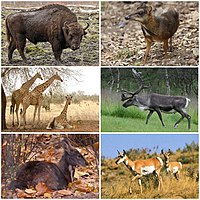
Photo from wikipedia
The rumen microbial ecosystem provides ruminants a selective advantage, the ability to utilize forages, allowing them to flourish worldwide in various environments. For many years, our understanding of the ruminal… Click to show full abstract
The rumen microbial ecosystem provides ruminants a selective advantage, the ability to utilize forages, allowing them to flourish worldwide in various environments. For many years, our understanding of the ruminal microbial ecosystem was limited to understanding the microbes (usually only laboratory-amenable bacteria) grown in pure culture, meaning that much of our understanding of ruminal function remained a "black box." However, the ruminal degradation of plant cell walls is performed by a consortium of bacteria, archaea, protozoa, and fungi that produces a wide variety of carbohydrate active enzymes (CAZymes) that are responsible for the catabolism of cellulose, hemicellulose, and pectin. The past 15 years have seen the development and implementation of numerous next-generation sequencing (NGS) approaches (e.g., pyrosequencing, Illumina, and shotgun sequencing), which have contributed significantly to a greater level of insight regarding the microbial ecology of ruminants fed a variety of forages. There has also been an increase in the utilization of liquid chromatography (LC) and mass spectrometry (MS) that revolutionized transcriptomic approaches, and further improvements in the measurement of fermentation intermediates and end products have advanced with metabolomics. These advanced NGS techniques along with other analytic approaches, such as metaproteomics, have been utilized to elucidate the specific role of microbial CAZymes in forage degradation. Other methods have provided new insights into dynamic changes in the ruminal microbial population fed different diets and how these changes impact the assortment of products presented to the host animal. As more omics-based data has accumulated on forage-fed ruminants, the sequence of events that occur during fiber colonization by the microbial consortium has become more apparent, with fungal populations and fibrolytic bacterial populations working in conjunction, as well as expanding understanding of the individual microbial contributions to degradation of plant cell walls and polysaccharide components. In the future, the ability to predict microbial population and enzymatic activity and end products will be able to support the development of dynamic predictive models of rumen forage degradation and fermentation. Consequently, it is imperative to understand the rumen's microbial population better to improve fiber degradation in ruminants and, thus, stimulate more sustainable production systems.
Journal Title: Journal of animal science
Year Published: 2023
Link to full text (if available)
Share on Social Media: Sign Up to like & get
recommendations!